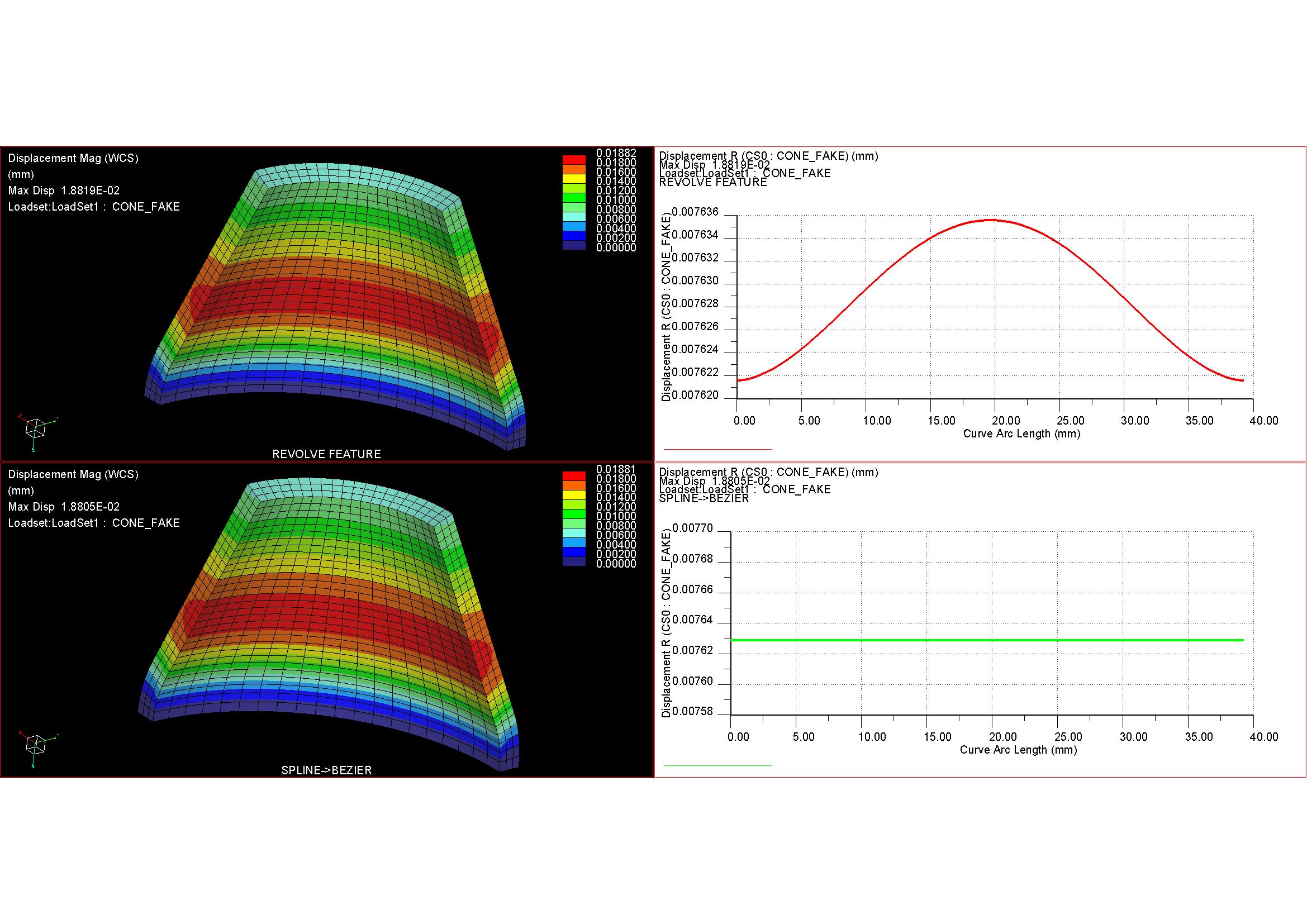Community Tip - Want the oppurtunity to discuss enhancements to PTC products? Join a working group! X
- Community
- Creo Elements Direct
- Drafting
- Re: Non-symmetric results for symmetric model and ...
- Subscribe to RSS Feed
- Mark Topic as New
- Mark Topic as Read
- Float this Topic for Current User
- Bookmark
- Subscribe
- Mute
- Printer Friendly Page
Non-symmetric results for symmetric model and load?
- Mark as New
- Bookmark
- Subscribe
- Mute
- Subscribe to RSS Feed
- Permalink
- Notify Moderator
Non-symmetric results for symmetric model and load?
Why is it that displacement for a cone is not rotational symmetric for an internal pressure?
A sample model is attached (Creo 3.0) I've brought it back to the bare minimum. 1/4 cone, symmetry, default mesh etc.
It doesn't help if you refine to enormous amounts of elements, Large deformationm analysis makes it slightly better, but it is never right?
Why is that? it should not happen.
How do we solve this?
Extra: I've added a full 360 degree version in Creo2.0 format
- Labels:
-
General
- Mark as New
- Bookmark
- Subscribe
- Mute
- Subscribe to RSS Feed
- Permalink
- Notify Moderator
Paul Kloninger wrote:
"Formation of element and nodes plays crucial role in analysis"
yes, exactly
Well, yes and no...
To play devil's advocate a little, 1) Simulate (Mechanica) is supposed to remove the need for the user to 'worry' about the mesh so much; and 2) surely for a simple analysis such as this, with very smooth stress and displacement contours, even a very 'poor' mesh should give the correct result? Particularly when looking only at displacement, for which a coarser mesh is traditionally considered adequate.
- Mark as New
- Bookmark
- Subscribe
- Mute
- Subscribe to RSS Feed
- Permalink
- Notify Moderator
Exactly as Jonathan puts it. This is a simple problem that for no reason at all sudeenly becomes something that needs special measures like a fien and regular mesh.
Unacceptable.
Even more unacceptable is that it seems to be normal that we, thed usedrs, need to find a workaround for this incorrect answer to a trivial question, while the software owner/ supplier/ maintainer does not seem to be able to come up with a better answer thna: You need a finer/ more regular mesh.
Unacceptable, that why I've given up on PTC as FEAnalysis software provider..
- Mark as New
- Bookmark
- Subscribe
- Mute
- Subscribe to RSS Feed
- Permalink
- Notify Moderator
example:

can you repair it?
Regards
Paul
- Mark as New
- Bookmark
- Subscribe
- Mute
- Subscribe to RSS Feed
- Permalink
- Notify Moderator
It's difficult to attach the result files,so sorry! Remember to use cylinder coordinate when you check the displacement !!!
- Mark as New
- Bookmark
- Subscribe
- Mute
- Subscribe to RSS Feed
- Permalink
- Notify Moderator
- Mark as New
- Bookmark
- Subscribe
- Mute
- Subscribe to RSS Feed
- Permalink
- Notify Moderator
Hi Erik
It seems as though the stiffness of elements is not being held constant during calculations.
If we take a simple example of a beam with constant area, its stiffness is AE/L, so stiffness is inversely related to length . As L goes up , stiffness goes down, so nodal displacements should increase. Also, we have applied pressure load, which should transform to perpendicular point load (P) at a beam end like this.(the beam becomes element edge) Delta should reflect the deformation.
In our cone model, even brick elements produce unequal edges, which are longer at center and shorter at ends.
I tried the model in first reply(by Matts) which produced good results initially but deviated once the thickness became variable, so element area seems to affect the calculations as well. Maybe thats why it was suggested to use thin solids.
Lastly I tried the above scenario with a quarter cylinder using a similar setup.
Again, the tetras(default) create unacceptable output. Both prismatic elements and brick elements produced clean results possibly because element edge lengths are uniform.
However, tetra output quality gets better as mesh gets finer.
Displacement graphs in tetra shows a very high variation(crest-trough) while the brick shows little change.
Tetra has a global peak at the center, which is not observed in bricks model. Also, the brick model is kind of repetition of a pattern which appears to depend on the no. of subdivisions.
Just a hunch but if this is the case, the software should do some sort of "internal normalizing" before publishing the results. Inputs are welcome.
- « Previous
- Next »





